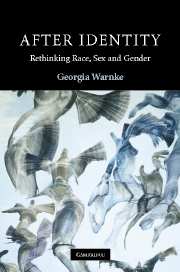Book contents
- Frontmatter
- Contents
- Acknowledgments
- Table of cases
- Introduction: reading individuals
- 1 The tragedy of David Reimer
- 2 Racial identification and identity
- 3 Race and interpretation
- 4 Sex and science
- 5 Rethinking sex and gender identities
- 6 Marriage, the military, and identity
- 7 Hermeneutics and the politics of identity
- Conclusion
- Index
Introduction: reading individuals
Published online by Cambridge University Press: 22 September 2009
- Frontmatter
- Contents
- Acknowledgments
- Table of cases
- Introduction: reading individuals
- 1 The tragedy of David Reimer
- 2 Racial identification and identity
- 3 Race and interpretation
- 4 Sex and science
- 5 Rethinking sex and gender identities
- 6 Marriage, the military, and identity
- 7 Hermeneutics and the politics of identity
- Conclusion
- Index
Summary
David Reimer's doctors thought that without a penis he could not be a boy. His parents and psychologists worried that he was not really a girl. At the age of three, James Morris decided that he was not a boy. The Texas Supreme Court concluded that Christie Littleton was not really a woman and the Kansas Supreme Court had the same view about J'Noel Ball. The International Olympic Committee decided Maria Patiño was a man while the United States Tennis Association (USTA) decided that Renée Richards was a woman. What are these decisions? How do we determine whether we and others are or are not men and women? What does it mean to be either?
The sense of these questions as I ask them here is different from the sense they have within discussions in moral psychology. Moral psychologists focus on the question of which descriptions of others or ourselves constitute depictions of our identities. The issue here is which sorts of properties that a person possesses count as parts of his or her identity and which sorts contribute only to trivial descriptions of the person. Thus, if it counts as part of one's identity that one is a man or a woman – if, in other words, this fact is not simply a trivial description – the question moral psychology asks is: Why? What constitutes possessing any particular identity? David Copp answers these questions in a way that highlights their difference from the questions I want to ask.
- Type
- Chapter
- Information
- After IdentityRethinking Race, Sex, and Gender, pp. 1 - 14Publisher: Cambridge University PressPrint publication year: 2008



